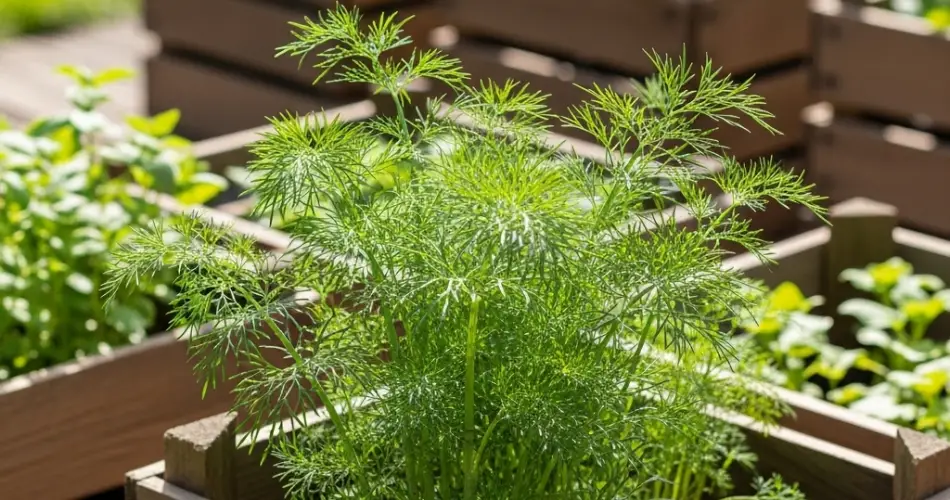Dill is a fragrant and versatile herb, prized for its feathery green leaves and aromatic seeds. Commonly used in pickling, salads, soups, and fish dishes, dill brings a distinctive flavor to a variety of culinary creations. For urban gardeners or anyone with limited outdoor space, growing dill in balcony crates is a practical and rewarding solution. Crate gardening allows you to maximize space, maintain control over soil and drainage, and enjoy fresh, homegrown dill at your fingertips. This guide provides comprehensive tips for cultivating healthy, productive dill plants in balcony crates.
Choosing the Right Crates
Wooden crates are ideal for container gardening due to their sturdiness, lightweight structure, and rustic appeal. They are often available as repurposed or upcycled materials, making them an eco-friendly choice. Ensure crates are clean, structurally sound, and free of harmful chemical treatments. Plastic crates can also work if they provide adequate drainage. For crates without pre-drilled holes, create several small openings in the bottom to prevent waterlogging and root rot. Uniform crates give a neat, organized appearance, while mixing sizes or stacking crates can create an attractive, layered display.
Selecting the Location
Dill thrives in full sun, needing at least six hours of direct sunlight per day. Place your crates in the sunniest part of your balcony, terrace, or patio to encourage vigorous growth and robust flavor. Adequate sunlight enhances essential oils in the leaves and seeds, increasing aroma and taste. Make sure the location allows easy access for watering, harvesting, and general care, while providing some protection from strong winds or heavy rain that can damage the delicate foliage.
Preparing Crates for Planting
Proper drainage is critical for dill, which prefers light, well-draining soil. Begin by placing a thin layer of gravel, small stones, or broken terracotta at the bottom of each crate. This ensures excess water can escape and prevents root rot. Fill the crates with a nutrient-rich, well-draining potting mix. Dill thrives in moderately fertile soil, so adding compost or well-rotted manure will support healthy growth without encouraging excessive leafy growth at the expense of flavor. Leave about two centimeters of space at the top of the crate for watering and to prevent soil spillage.
Planting Dill
Dill grows easily from seeds and can also be propagated from small nursery plants. For seeds, sprinkle them evenly across the soil surface and lightly cover with a thin layer of soil. Keep the soil consistently moist until germination, which typically occurs within 10–14 days. For nursery plants, gently loosen the roots before planting and space plants approximately 20 centimeters apart. Adequate spacing promotes airflow, prevents overcrowding, and encourages bushy, healthy growth that maximizes leaf and seed production.
Watering and General Care
Dill prefers moderate, consistent watering. Water deeply when the top layer of soil begins to dry, ensuring moisture reaches the roots without causing waterlogging. Mulching with straw, shredded leaves, or small stones helps retain moisture, regulate soil temperature, and suppress weeds. Regular trimming encourages bushier growth, prevents legginess, and promotes sustained leaf production. Remove any yellowing or damaged leaves to maintain plant health and prevent disease.
Fertilization and Growth Tips
Dill is relatively low-maintenance but benefits from occasional light fertilization. Apply a balanced, water-soluble fertilizer every four to six weeks to support strong growth and abundant leaf production. Avoid over-fertilizing, which can cause rapid leafy growth with less flavor. Healthy, well-maintained dill plants in crates can produce flavorful leaves and seeds throughout the growing season, providing a continuous supply for cooking and pickling.
Pest and Disease Management
Dill is generally hardy but may attract pests such as aphids or caterpillars. Inspect plants regularly and treat infestations with organic insecticidal soap or gentle water sprays. Good spacing, proper airflow, and well-draining soil reduce the risk of fungal diseases like powdery mildew. Healthy plants are more resilient and less susceptible to pest and disease problems, ensuring a continuous harvest.
Harvesting Dill
Harvest leaves once the plants are well-established and 15–20 centimeters tall. Cut outer leaves first, leaving the inner shoots intact to encourage continuous growth. Dill seeds can be collected once the flower heads mature and turn brown. Regular harvesting promotes bushier plants and ensures a steady supply of fresh leaves for culinary use. Leaves can be used fresh, dried, or frozen, while seeds provide long-term flavoring for pickles and other recipes.
Decorative and Practical Benefits
Crate-grown dill is both functional and visually appealing. The feathery green foliage adds texture and charm to balconies, terraces, and small gardens. Using repurposed crates promotes sustainability, reduces waste, and demonstrates an eco-friendly approach to gardening. Dill also attracts beneficial pollinators such as bees, contributing to a healthy balcony ecosystem.
Expanding Your Balcony Herb Garden
Once your dill crates are established, consider planting complementary herbs like parsley, cilantro, or chives. These herbs thrive under similar conditions and create a diverse, aromatic container garden. Staggering or stacking crates vertically maximizes space while producing a lush, productive, and visually engaging display.
Growing dill in balcony crates is a practical, sustainable, and space-efficient way to enjoy fresh, flavorful herbs. With proper sunlight, soil, watering, and care, your crate dill garden will flourish, providing aromatic leaves, harvestable seeds, and an attractive, functional addition to your balcony or patio garden.



